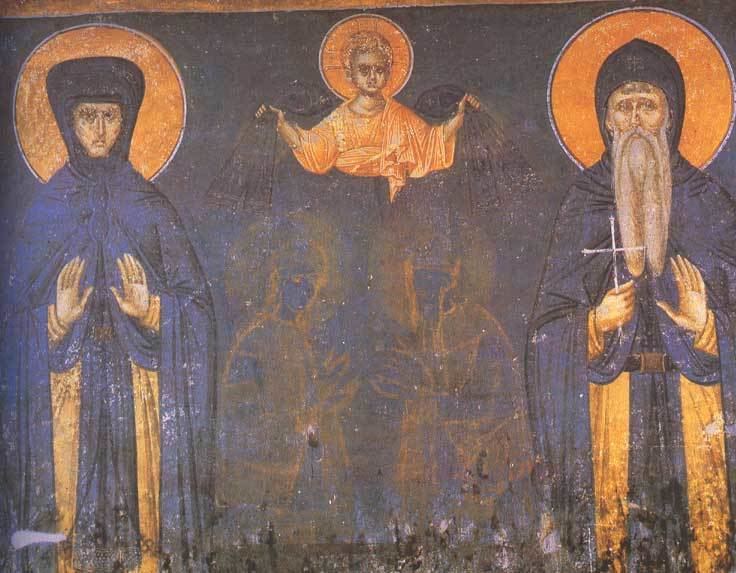Tenure around 1245 – 1276 Spouse Stefan Uros I of Serbia Name Helen Anjou | Signature | |
 | ||
Issue Stephen Dragutin,Stephen Uros II Milutin,Stefan,Brnjaca Died February 8, 1314, Shkoder, Albania Children Stefan Milutin, Stefan Dragutin of Serbia, Brnjaca Nemanjic Grandchildren Stefan Decanski, Stefan Konstantin, Vladislav, King of Syrmia, Ana-Neda, Zorica, Elizabeth of Serbia Great grandchildren Stefan Dusan, Stephen II, Ban of Bosnia Similar People Stefan Uros I of Serbia, Stefan Dragutin of Serbia, Stefan the First‑Crowned, Stefan Decanski, Simonida | ||
Helen of Anjou (Serbian: Jelena Anžujska/Јелена Анжујска, [jɛ̌lɛna ǎnʒuːjskaː]; c. 1236 – 8 February 1314) was the Queen consort of the Serbian Kingdom, as spouse of King Stefan Uroš I. Her children were later kings Stefan Dragutin and Stefan Milutin.
Contents
Origin
Her origin is not known for certain; she was born in ca 1236, and the biography of Archbishop Danilo states that "she was of a French family" and a continuator of the work that "the family was of royal or imperial blood". John Fine, Jr. states that she was "of Catholic and French origin, probably of the House of Valois". According to Europäische Stammtafeln, she descended from a side branch of the Byzantine emperor's family and the Hungarian royal house, in which case she may have been the daughter of John Angelus of Syrmia and a sister of Maria Angelina, wife of Anselm de Keu (Anseau de Cayeux), Captain General in Albania for Charles I of Naples. Charles I mentioned her as a relative in a letter dated 1273. She may have been the granddaughter of the sister of Baldwin II of Constantinople.
In 1280, Charles I of Sicily issued documents to Maria Angelina allowing her to travel from Apulia to Serbia to visit "her sister the queen of Serbia". Maria Angelina's parents are known from her marriage license, issued in 1253 by the pope, as Calojohanni and imperatore Constantinopolitano, eiusdem Matildis avunculo...Matildis dominæ de Posaga, natæ comitissæ Viennensis, that is, Kaloioannes Angelos, lord of Srem, and Mathilde, daughter of Marguerite de Courtenay (the sister of the Latin emperors Robert and Baldwin II) and Heinrich, count of Vianden. Therefore, Helena, like her sister Maria, was a paternal granddaughter of the Byzantine emperor Isaakios II by his second wife, Margit of Hungary.
Queen consort
Helen married Uroš I around 1245. With Uroš I she had at least four children:
For some time, she was a ruler of Zeta, Travunia, Plav and Poibarje. During that time, Serbia was divided into three parts, and the rulers of the other two parts were Dragutin and Milutin. Helen became a nun at the Church of St. Nicholas in Shkodër, where she died on 8 February 1314.
Helen of Anjou significantly contributed to the cultural rise of the medieval Serbian state. She had the first library at the court and encouraged transcription of books in monasteries. She founded the first girls' school in medieval Serbia. Helen's palace was in modern Kosovo, in the town of Brnjak (sometimes called "Brnjaci", but not the place of that name in Bosnia and Herzegovina), on Mokra Gora mountain (not to be confused with Mokra Gora village), where the school was located. Other than this palace, she possessed the town of Jelač at Rogozna mountain. As did other Nemanjićs, she built monasteries. She built the Gradac Monastery, where she was buried, the Church of St. Nicholas in Shkodër where she died, and the Shirgj Monastery.
Legacy
Helen of Anjou was canonized by the Serbian Orthodox Church. Her feast day is 12 November [O.S. 30 October].
Lilacs were planted along the Ibar River to welcome Helen of Anjou to her new home in Serbia. Her husband planted them to remind her of her home in Provence. This area is now known as the Valley of the Lilacs.
